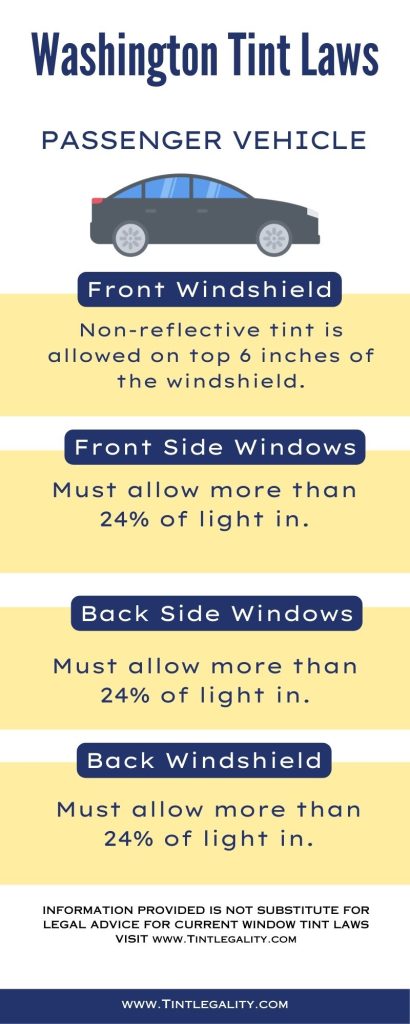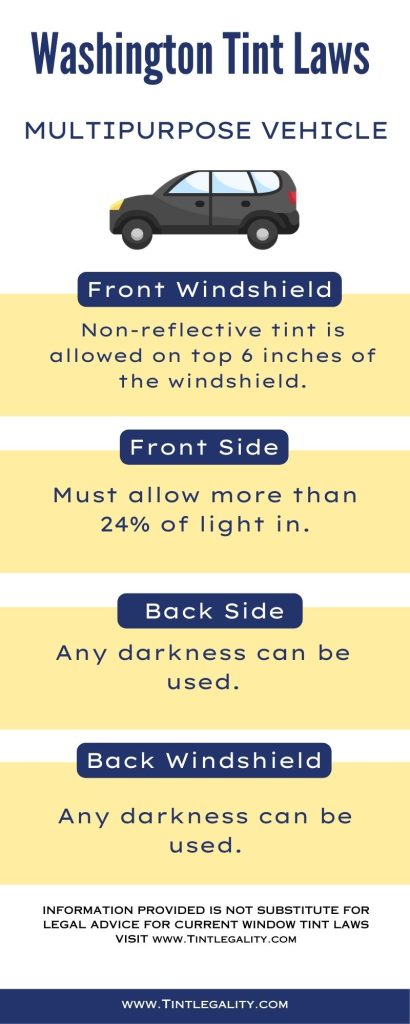The Washington Tint Laws were enacted in 2011, revolutionizing how the state views and regulates window tints.
This comprehensive set of rules governs everything from the darkness of your tint to its reflective capabilities, all under the umbrella of Washington’s commitment to road safety.
Regulations Regarding Window Tint in Washington
In Washington, the window tint laws are notably specific.
They dictate not only the percentage of visible light allowed through your vehicle’s windows, also known as Visible Light Transmission (VLT) but also the level of tint reflectiveness.
VLT refers to the percentage of light a window tint film allows to pass through your car windows.
In Washington, the percentage of light allowed through the film and glass varies depending on the type of vehicle – whether it’s a sedan, SUV, or van.
| Window | Sedan | SUV & Van |
|---|---|---|
| Windshield | Non-reflective tint is allowed in the top 6 inches of the windshield | Non-reflective tint is allowed in the top 6 inches of the windshield |
| Front Side Windows | Must allow more than 24% of light in | Must allow more than 24% of light in |
| Back Side Windows | Must allow more than 24% of light in | Any darkness can be used |
| Rear Window | Must allow more than 24% of light in | Any darkness can be used |
| Mirror | Left and right side mirrors are required if the back window is tinted | Left and right side mirrors are required if the back window is tinted |
| Restricted Tint Colors | Amber, Red, and Yellow are not allowed | |
| Window Tint Reflection | Window tint can reflect incoming light but not more than 35% | |
Windshield
Whether you own a sedan or an SUV, the laws for windshield tinting remain consistent. Non-reflective tint is allowed along the top six inches of the windshield.
This law maintains driver visibility while providing some relief from the sun.
Front Side Windows
The laws take a slight turn when we talk about front side windows.
Both sedans and SUVs must allow over 24% light inside.
This is to ensure the driver has a clear view of the side mirrors and the road.
Back Side Windows
Interestingly, the tint darkness rules are different for back side windows.
For sedans, they must allow more than 24% light inside.
However, for SUVs and vans, the laws are more relaxed, and any level of darkness can be used.
Rear Window
Similar to the back side windows, for sedans, the rear window must allow more than 24% light inside.
But again, for SUVs and vans, there’s more flexibility with any level of darkness being permissible.


Additional Regulations
There are also some critical regulations that drivers should be aware of.
For instance, the state requires dual side mirrors if the back window is tinted.
This is to ensure drivers have adequate visibility, even with darker rear windows.
Reflection
Reflecting incoming light is another function of window tints.
In Washington, your window tint should not be more than 35% reflective.
This law applies to both sedans and SUVs, regardless of whether we’re talking about front or back side windows.
Medical Exemptions
The state of Washington also provides medical exemptions for special tint.
People with certain medical conditions may be exempt from some of the restrictions of the window tint laws.
Color Restrictions
When it comes to color, Washington tint laws are again specific.
The state does not allow yellow, red, or amber window tints.
This is to avoid any confusion with emergency vehicles and traffic signals.
Side Mirrors
An interesting provision in Washington tint law is the requirement for dual side mirrors when the back window is tinted. This ensures that visibility is not compromised for safety.
Exceptions to Legal Limits
There are exceptions to these limits in Washington.
For instance, ambulances and law enforcement vehicles are not subject to the same restrictions as personal vehicles.
Penalties for Breaking the Law
Breaking the Washington tint law comes with its set of repercussions.
Fines
The fine structure for violating the Washington tint law is progressive, increasing with each subsequent conviction.
First Conviction
For a first conviction, the fine can be a wake-up call to adhere to the window tint laws.
Second Conviction
A second conviction will result in a heftier fine, serving as a more serious deterrent against breaking the law.
Third Conviction
By the time a driver reaches their third conviction, the fine increases significantly.
This hefty fine is designed to discourage repeat offenders.
Other Penalties
Apart from fines, other penalties may also be enforced for non-compliance with the window tint laws.
For instance, drivers may be required to remove the illegal tint from their windows, which could involve additional costs.
Penalties for Non-Compliance
Non-compliance with Washington tint laws can also affect your insurance rates.
Insurance companies may increase your premiums if you have illegal tints, as this could be seen as a risk factor.
Washington tint laws are a testament to the state’s commitment to road safety.
By regulating the darkness and reflectivity of window tints, the state ensures that visibility is not compromised for drivers, making the roads safer for everyone.
As a driver in Washington, it is crucial to understand these laws and abide by them, not only to avoid fines and penalties but more importantly, to ensure your safety and that of other road users.
FAQ’s
Is 20% tint illegal in Washington state?
Yes, 20% tint is illegal; Washington state requires a minimum of 24% light transmission.
Can you get pulled over for tinted windows in Washington?
Yes, you can get pulled over for illegally tinted windows in Washington.
How much is a tint ticket in Washington?
The fine for a tint violation varies but typically ranges from $124 to $250.
Is 5% tint legal in Washington?
No, 5% tint is not legal in Washington; it’s darker than the allowed limit.
References: